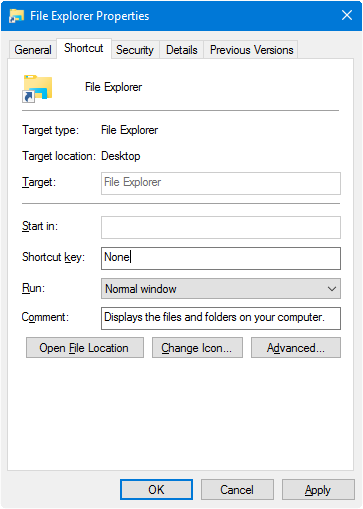how to change the target of a shortcut in windows 10
The WinKey + E keystroke, every bit well as the File Explorer shortcut on the taskbar, open Quick access view by default. You can change the default folder to This PC using Folder Options Full general tab, or get in open to the Downloads folder using a registry method.
But, how to make Windows 10's File Explorer default to a custom binder or the Libraries section?
The user interface provides no option to prepare a custom destination for WinKey + East keystroke or the File Explorer pinned taskbar item. As you may have noticed, the File Explorer Pinned taskbar shortcut target can't be modified via Properties, as information technology'due south a special shortcut with the Target field grayed out or read-but.

However, you change the WinKey + E or the File Explorer shortcut target using a registry edit without breaking any other setting.
Change WinKey + Eastward and File Explorer Shortcut Target
To set a default start folder for File Explorer, follow these steps:
- Re-create the post-obit code to Notepad, and save the file every bit
launch.vbsin a rubber and protected location.WScript.CreateObject("Wscript.Vanquish").Run "C:\MyFolder"
The above code launches File Explorer to the specified folder. Change the target folder path accordingly as per your requirement.Brand File Explorer default to Libraries
To make File Explorer open to the Libraries section (instead of a folder) by default, alter the target in the script file, equally follows:
WScript.CreateObject("Wscript.Shell").Run "%appdata%\Microsoft\Windows\Libraries"Make File Explorer default to Desktop folder
To start Explorer on the Desktop folder, use this code:
WScript.CreateObject("Wscript.Shell").Run "beat:desktop" - Open Regedit.exe and create the following registry branch.
HKEY_CURRENT_USER\SOFTWARE\Classes\CLSID\{52205fd8-5dfb-447d-801a-d0b52f2e83e1}\vanquish\opennewwindow\controlNotation that the cardinal {52205fd8-5dfb-447d-801a-d0b52f2e83e1} doesn't exist by default and you'll need to create the cardinal & its subkeys manually. Alternately, you can employ the REG file method mentioned in the next paragraph to create the key/values automatically.
- Fix the (default) value data as:
wscript.exe d:\launch.vbs
(Assuming
launch.vbsis saved ind:\drive.)
Quick Tip: You can even blazon an application path if you want to invoke the application using WinKey + Due east. - Create a string (REG_SZ) value named DelegateExecute setting its value information empty.
- Exit the Registry Editor.
Automate the above steps using REG file
Hither is the .reg file for the higher up settings. Run across how to create and use .reg files in Windows.
Windows Registry Editor Version 5.00 [HKEY_CURRENT_USER\SOFTWARE\Classes\CLSID\{52205fd8-5dfb-447d-801a-d0b52f2e83e1}\trounce\opennewwindow\command] @="wscript.exe d:\\launch.vbs" "DelegateExecute"="" The above registry tweak changes the default target path for WinKey + E besides as the special File Explorer shortcut in Windows ten.
Why is a Script necessary?
You may exist wondering why we demand to use a script to get-go File Explorer to open up to a specific folder. Why not create a new desktop shortcut with explorer.exe <folderpath> as the target?
Running the explorer.exe <folderpath> via a shortcut or control-line would create a dissever explorer.exe process each time. And the additional instances of Explorer.exe remain open even later closing the folder. This also creates multiple and independent File Explorer icons on the Taskbar.

The script method prevents the above issues.
Selection two: Using AutoHotkey
Y'all can utilise the fantabulous automated tool AutoHotkey to intercept the Winkey + E hotkey and launch the desired folder or program.
- Download and install AutoHotkey.
- Using Notepad, create a .ahk file with the following contents:
#eastward::run "shell:desktop"
- Name the appropriately , e.grand.,
change_win_e_target.ahk - Double-click the .ahk file to run it.
Now, pressing Winkey + E will launch the Desktop folder. Replace the target binder in the script file as desired.
Note that the AutoHotkey method is extremely quick compared to the VBScript method. Simply it doesn't change the File Explorer taskbar shortcut target, whereas the VBScript (& registry) method works with File Explorer taskbar shortcut every bit well as Winkey + Due east.
One small request: If you liked this post, please share this?
One "tiny" share from yous would seriously help a lot with the growth of this weblog. Some great suggestions:
And so thank y'all so much for your back up, my reader. It won't take more than ten seconds of your time. The share buttons are correct below. :)
Source: https://www.winhelponline.com/blog/winkey-e-shortcut-target-change/
Posted by: millercallynnusers.blogspot.com


0 Response to "how to change the target of a shortcut in windows 10"
Post a Comment